

Discovery of Oldest Petroglyphs in North America Raises Some Interesting Questions
Scientists announced the confident dating of the oldest known petroglyphs in North America. Petroglyphs are man made carvings in stone, usually forming a picture, pattern and often telling a story. They are very old.
Basing their calculations on the well documented geological history of the petroglyph site in Nevada, they realized that the site was only above the surface of an adjacent lake for a narrow (geologically speaking) span of time before the current era.
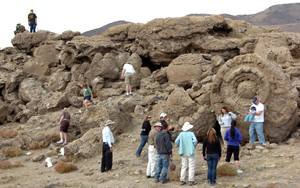 Petroglyphs are almost impossible to date. Carbon-14 methods require once-living material to analyze. Carved or chipped rock can only be directly dated by the highly inaccurate method of examining the patina.
Petroglyphs are almost impossible to date. Carbon-14 methods require once-living material to analyze. Carved or chipped rock can only be directly dated by the highly inaccurate method of examining the patina.
Minerals inside the rock leach to the surface from exposure to rain and sunlight. Over eons of time this forms a hard crust (or "patina") which usually takes on a darker color than the rock underneath.
This "patina" is what interested the early petroglyph makers in selecting where to chip. As the patina is chipped away, the lighter rock underneath creates a dramatic contrast for drawing. The thickness of the patina depends not only on the age of the rock but also the environment. That is why it is considered inaccurate.
In this new discovery, the environment where the ancient petroglyphs are located was used to determine an age when they could have been created. The land was submerged under a lake except for two well documented spans of time in the past.
"In order to determine the age of this set of petroglyphs in Nevada, researchers studied the calcium carbonate deposit layer on the rock's surface -- an indicator that the rocks had once been submerged in water. Between 13,000 and 15,000 years ago, the lake levels dropped below the level of the boulders."
--Dr. Eugene Hattori, an anthropologist with the Nevada State Museum
Scientists concluded that the incisions were made before the water levels rose during the Ice Age, and the Lake Lahontan formation. The now-dry Winnemucca Lake was a remnant of Lake Lahontan.
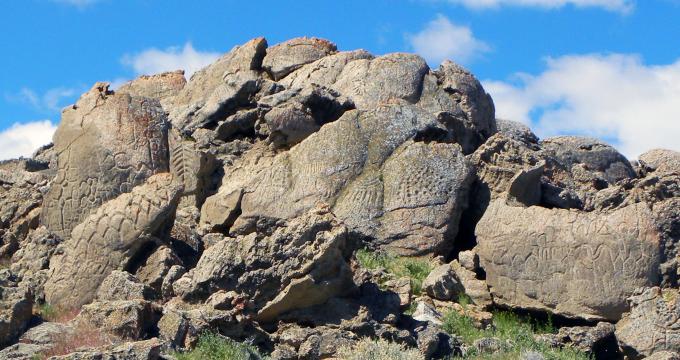
[Above: Notice the wavy pattern on the left and compare this to some other sites below.]
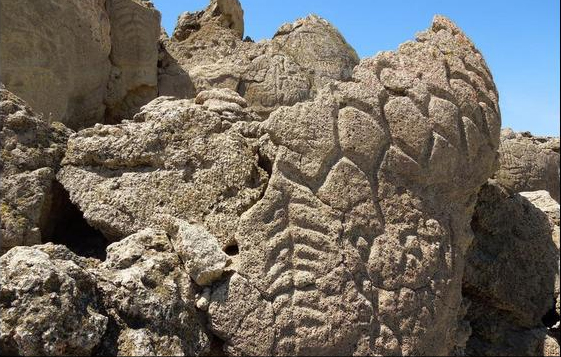
You can check out the original discovery here: ScienceDirect.com
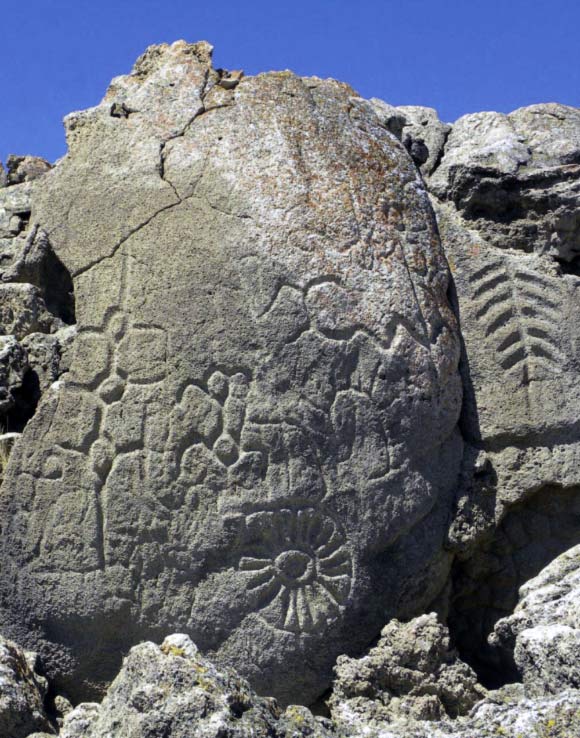
Could this be CLOVIS art?
Until this discovery, the oldest petroglyphs were in Oregon and dated to 6,500 years ago. This new date in Nevada pushes the record of human habitation back to about 13,000 BC and coincides with the late phase of Clovis culture, before they disappeared from history.
Other archaeological sites containing less technical artifacts have since been discovered and date as far back as 20,000 years ago. But the Clovis culture seems to have been the most advanced paleo-Indian civilization.
The Clovis culture is a name given to the paleo-Indians who inhabited the Western part of North America about 13,500+ years ago. Their name is derived from the town in New Mexico where a the collection of unique arrowheads and cutting tools were found -- intact with organic material for carbon-14 dating.
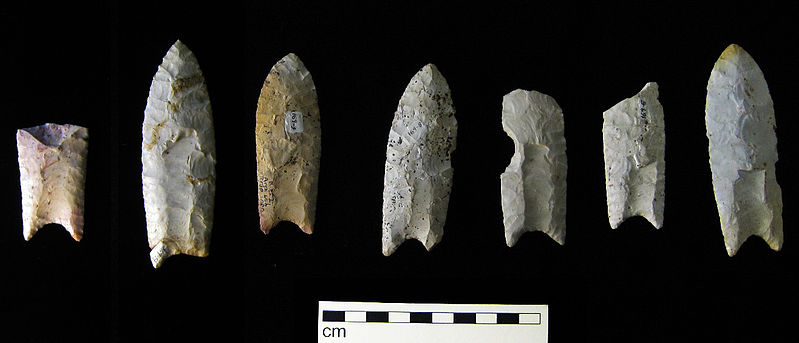
The Clovis point is a remarkable tool and the "hi-tech" of the stone age. It was very strong and resisted cracking or chipping. It incorporated grooves for attachment and was apparently quite successful in the hunt.
But what is most remarkable about the Clovis point is that it was made exactly the same by many distant colonies and the method of construction seems to have been learned and taught over many generations. This kind of social organization suggests that the petroglyphs made by these people may be more than meaningless "doodles" or graffiti. We'll explore that in a minute.
For a long time archaeologists believed the Clovis civilization was the oldest inhabitant of the North American continent. But recent discoveries have pushed the earliest inhabitants, thought to have come from Asia, to thousands of years earlier.
Another theory, growing in popularity, is that North America was inhabited as much as 26,000 years ao by European's known as Solutreans. Spear points and hunting aftifacts have been found 60 miles off the Virginia coast in what was the coastal area during the height of the last ice age.
If the petroglyphs at the Nevada site are not the art or writing of the Clovis culture, it is certainly from a civilization that preceded or co-existed with them, perhaps Solutrean.
Something familiar...
Examining the shapes and designs of these 13000+ year old petroglyphs immediately reminds me of similar petroglyphs photographed in Colorado on a Viewzone Expedition. If you look closely you will see many similarities.

These petroglyphs are located on cattle grazing land outside La Junta, Colorado. They are part of a large cache of petroglyphs that are unfortunately unprotected and subject to vandalism.

What do the petroglyphs mean?
A few years ago, Viewzone conducted several expeditions in Colorado to examine the possibility that some of these petroglyphs were actually records of phonetic sounds representing the language spoken by their creators.
Successful translations used an ancient dialect that preceded Hebrew and Arabic. Although much of the translated texts were mundane (describing locations of water and hunting) other texts described some kind of event which required shelter. (see viewzone articles)
The phenomenon is not limited to Colorado or the Western states of America. "Plasma trees" have been recorded all over the globe from this same time period. Below is an example of a "tree" recorded in petorgyphs from Paraguay.
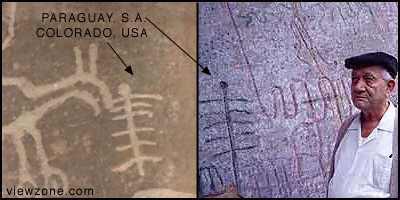
What happened 13,000 years ago?
A recent story on ScienceDaily read: Mass Extinction -- Why Did Half of N. America's Large Mammals Disappear 13.8 and 11.4 Thousand Years Ago?
Years of scientific debate over the extinction of ancient species in North America have yielded many theories. However, new findings from J. Tyler Faith, GW Ph.D. candidate in the hominid paleobiology doctoral program, and Todd Surovell, associate professor of anthropology at the University of Wyoming, reveal that a mass extinction occurred in a geological instant.
During the late Pleistocene, which ended around 12,700 years ago, North America lost over 50 percent of its large mammal species. These species include mammoths, mastodons, giant ground sloths, among many others. In total, 35 different genera (groups of species) disappeared, all of different habitat preferences and feeding habits.
Whatever happened to cause the extinction did not span hundreds or thousands of years -- it was likely less than a decade. It was quick and struck without warning.
What kind of event could cause a mass extinction?
Pieces of the puzzle
Glazed donuts on the Moon
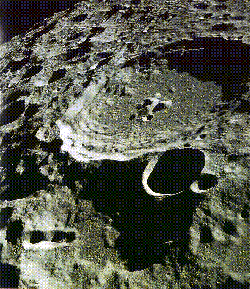 Let's begin back in the 1960s with the Apollo 11 manned landing on the moon. On one of their EVA's (extra-vehicular activities), the astronauts photographed and took samples from some small craters, about 20cm to 1.5 meters across. When they examined the floors of these craters they noticed what looked like glazed donuts. These were actually chunks of moon dirt that were coated by glass.
Let's begin back in the 1960s with the Apollo 11 manned landing on the moon. On one of their EVA's (extra-vehicular activities), the astronauts photographed and took samples from some small craters, about 20cm to 1.5 meters across. When they examined the floors of these craters they noticed what looked like glazed donuts. These were actually chunks of moon dirt that were coated by glass.
The glazed areas are clearly concentrated toward the top surfaces of protuberances, although they exist also on some sides. Points and edges appear to be strongly favored for the glazing process. In some cases, droplets appear to have run down an inclined surface for a few millimeters and congealed there. [1]
Hardly anyone in the general public was made aware of this discovery and, even if they were, thay could hardly have realized the significance.
But in 1969, an article in Science by T. Gold [1] proposed a theory of how they were made. Glass, as we know, is made from melting sand. It occurs natually near sources of high temperature, such as volcanos and meteor impacts. The atom bomb tests in New Mexico's White Sands area produced a small "lake" of glass at ground zero. So it was never a question about the lunar glass also having been created by something very hot.
The fact that the glaze was confined to small patches, 0.5 to 10mm, suggested to scientists that the surface had been zapped rather than slow-cooked. And the likely source of this zap was our Sun. Gold estimated that the solar luminosity would have had to increase by 100 times what it is normally, for a duration of from 10 to 100 seconds.
Also, because of the lack of debris or dirt covering this glass, it must have occurred within the last 30,000 years. This made Gold propose that the Sun -- our Sun -- does this every 10,000 years or more. He suggested that future research should look for a "trigger" event -- possibly a large comet or asteroid impacting the surface of the Sun. He estimated this would only have to be 100 km and weigh 3 x 1021 grams.
 Decades passed and this theory didn't receive much attention. Then, as it often does, the theory got a fresh look by a genius, Dr. Paul LaViolette. He was not satisfied with the source of the glass being caused by a solar blast, mainly because the output would have had to be on the scale of a nova, not just a flare. He envisioned another possibility.
Decades passed and this theory didn't receive much attention. Then, as it often does, the theory got a fresh look by a genius, Dr. Paul LaViolette. He was not satisfied with the source of the glass being caused by a solar blast, mainly because the output would have had to be on the scale of a nova, not just a flare. He envisioned another possibility.
LaViolette envisioned a large solar flare or coronal mass ejection (CME) that would become magnetically entrapped in the Earth's magnetosphere [2]. The magnetosphere would then hold on to this fireball of radiation like a magnetic thermos bottle, allowing the Moon and Earth to be exposed for a duration of time long enough to really "flash bake" their surfaces.
Critics quickly denounced LaViolette's theory citing evidence of "cosmic dust" and rare elements in the lunar glass and concluding that the heat source was from a meteor impact. [3]
But LaViolette proposed that this cosmic dust was likely present on the surface of the Moon during the time it was melted into the glass. In fact, he proposed that the entire solar system was full of this cosmic dust at the time of this solar eruption.
He was vindicated when polar ice cores showed unusual cosmic dust deposits at srata marking the end of the last ice age [4]. This time period, about 12,875 years ago, approximates the current age of the Moon glass. So where did all this cosmic dust come from?

Like Earth, our entire solar system has its own atmosphere, called the heliopause. This "bubble" surrounds the Sun and planets as it travels through galactic space. Like our earth's magnetosphere, the movement of the heliopause creates a rounded "head" and a narrowing "tail." Actually, it's more egg shaped (see above).
Until recently, astronomers believed that our solar system was a region relatively free from cosmic dust. The cosmic dust and frozen material of space were kept outside this protective bubble.
This was confirmed when the IRAS and Ulysses spacecrafts showed infrared images of the solar system, surrounded by whispy clouds of cosmic dust that increase in density just beyond Saturn.
So if the cosmic dust is surrounding the heliopause, what would make it suddenly enter the heliopause and how would this coincide with huge solar flares? LaViolette envisioned something disrupting the heliopause from the outside, impacting it and drawing cosmic dust inside with it and energizing the Sun. The energy of such an impact would be immense. The most logical place to look for such enormous energy was the Milky Way Galaxy.
The smoking gun
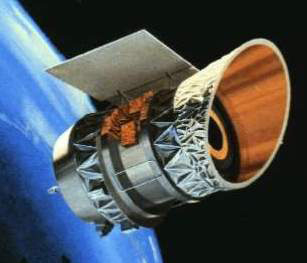 Examining the shape of the cosmic dust clouds, the IRAS satellite team reported that the cloud was tilted relative to the solar system's ecliptic -- the narrow plane containing our planets. LaViolette realized that this odd alignment tracked back to the Galactic center. This was quickly verified by NASA's Ulysses spacecraft and New Zealand's AMOR space radar observatory. Whatever caused the last ice age to end, the Sun to flare up and caused the glass to form on the Moon, came from the center of the Milky Way Galaxy. The plot was getting more interesting.
Examining the shape of the cosmic dust clouds, the IRAS satellite team reported that the cloud was tilted relative to the solar system's ecliptic -- the narrow plane containing our planets. LaViolette realized that this odd alignment tracked back to the Galactic center. This was quickly verified by NASA's Ulysses spacecraft and New Zealand's AMOR space radar observatory. Whatever caused the last ice age to end, the Sun to flare up and caused the glass to form on the Moon, came from the center of the Milky Way Galaxy. The plot was getting more interesting.
Astronomers have known about intense radiation from space since the 1970s. Multiple bursts of powerful gamma rays were routinely detected and believed to originate from stars in the Milky Way. Assuming this energy originated locally, astronomers concluded this type of gamma ray burst was insignificant and harmless. Then, in December 1997, they had the technology and good luck to catch a strong gamma ray burst and track it. The source was not inside the Milky Way Galaxy. It was from a distant galaxy billions of light years away.
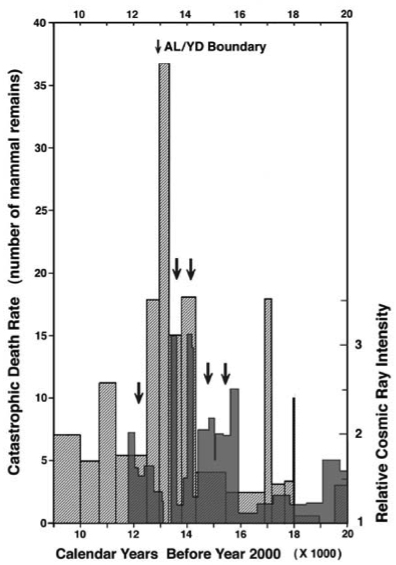 A review of other bursts showed that their assumptions had been wrong. All of the gamma ray bursts they were observing were from other galaxies far, far away. The amount of energy coming from objects so distant was a real shock. No one had ever imagined such powerful bursts could be generated by galactic centers. The thought of a burst coming from our own Milky Way galactic center was abysmal. A burst of the same intensity as the 1997 event, originating from inside the Milky Way, would deliver 100,000 time the lethal dose of radiation, killing every life form that was exposed. Could that really happen to us?
A review of other bursts showed that their assumptions had been wrong. All of the gamma ray bursts they were observing were from other galaxies far, far away. The amount of energy coming from objects so distant was a real shock. No one had ever imagined such powerful bursts could be generated by galactic centers. The thought of a burst coming from our own Milky Way galactic center was abysmal. A burst of the same intensity as the 1997 event, originating from inside the Milky Way, would deliver 100,000 time the lethal dose of radiation, killing every life form that was exposed. Could that really happen to us?
This question was answered on August 27th, 1998 when an unusual 5 minute gamma ray pulse was located just 20,000 light years away in the constellation of Aquila. This may sound like a huge distance, but to astronomers this is just "next door." The Milky Way Galaxy, for example, is just 100,000 light years from end to end.
The 1998 event was close enough and strong enough to ionize Earth's upper atmosphere, damage a couple of spacecraft and disrupt global communication. Since then astronomers place gamma ray bursts from the Glaxy's core at the top of the list of things we do not want to happen.
Before Aquila, scientists just feared exploding stars -- novas and supernovas. Now things are different. It's like living in a ghetto and fearing drive-by shootings and random bullets. Then one day you learn that there's a nuclear bomb down the street, waiting to explode.
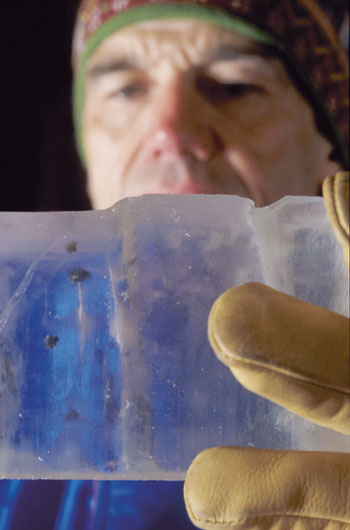 Not in my galaxy!
Not in my galaxy!
Ironically, all of these facts are incorporated in LaViolette's "superwave" theory. He concludes that there are cyclical and frequent explosions from the Galaxy's core. These waves of radiation advance outward to the edges of the Galaxy, impacting everything and causing stars to erupt in their path. He believes this is what has happened many times to our own solar system -- the most recent superwave of radiation being 12,800 years ago (approximately 10,800 BC). He envisions the shock wave -- or superwave -- dragging cosmic dust along with it as it enters the heliopause and energizes our Sun.
Archaeologists' most precise determinations at present suggest that the Clovis culture endured from around 13,500 to 13,000 calendar years ago, or about 11,500 to 11,000 BCE. This roughly coincides with the cosmic dust found in ice cores. (just 200 years difference)
Ice core samples support this view. Evidence of the effects from cosmic dust show at ice core strata corresponding to the years 10,880 to 10,785 BCE*, or around 12,800 years ago. This evidence, along with the Moon glass, the presence of cosmic dust and the abrupt and atypical end of the last ice age -- all point to an intimate relationship between extreme solar activity and gama radiation from the Milky Way Galaxy's center. [* These dates have been updated following more precise research from Dr. LaViolette.]
So... what did Clovis see and record in their petroglyphs?
NEXT: What Clovis Saw -- Plasma columns and Z-pinches in the sky!

[1] Gold, T. "Apollo II Observations of a Remarkable Glazing Phenomenon on the Lunar Surface." Science 165 (1969):1345.
[2] Excerpt from Paul LaViolette's 1983 Ph.D. dissertation, "Galactic Explosions, Cosmic Dust Invasions, and Climate Change."
[3] Morgan, Laul, Ganapathy, and Anders (1971 Morgan, J. W., Laul, J. C., Ganapathy, R., and Anders, E. "Glazed Lunar Rocks: Origin by Impact." Science 172(1971):556
[4] Zook, H. A., Hartung, J. B., and Storzer, D. "Solar Flare Activity: Evidence for Large Scale Changes in the Past." Icarus 32(1977):106
[5]Anthony L. Peratt, Fellow, IEEE, John McGovern, Alfred H. Qoyawayma, Life Member, IEEE, Marinus Anthony Van der Sluijs, and Mathias G. Peratt, Member, IEEE, "Characteristics for the Occurrence of a High-Current Z-Pinch Aurora as Recorded in Antiquity Part II: Directionality and Source," IEEE Transactions on Plasma Science, Vol. 35, NO. 4, August 2007.
[6] Markus Landgraf, Max Plank Institute.
[7] www.viewzone.com/comanche2.html -also- www.viewzone.com/firsttongue.yemen.html -also- www.viewzone.com/oklahoma11.html
From Wikipedia, the free encyclopedia
The Clovis culture (sometimes referred to as the Llano culture) is a prehistoric Paleo-Indian culture, named after distinct stone tools that were found at sites near Clovis, New Mexico, in the 1920s and 1930s. The Clovis culture appears around 11,500 RCYBP (radiocarbon years before present), at the end of the last glacial period, characterized by the manufacture of "Clovis points" and distinctive bone and ivory tools. Archaeologists' most precise determinations at present suggest that this radiocarbon age is equal to roughly 13,500 to 13,000 calendar years ago.
The Clovis culture was replaced by several more localized regional cultures from the time of the Younger Dryas cold climate period onward. Post-Clovis cultures include the Folsom tradition, Gainey, Suwannee-Simpson, Plainview-Goshen, Cumberland, and Redstone. Each of these is commonly thought to derive directly from Clovis, in some cases apparently differing only in the length of the fluting on their projectile points. Although this is generally held to be the result of normal cultural change through time, numerous other reasons have been suggested to be the driving force for the observed changes in the archaeological record, such as Younger Dryas impact event or post-glacial climate change with numerous faunal extinctions.

Clovis Point
[Above A Clovis projectile point created using bifacial percussion flaking (that is, each face is flaked on both edges alternately with a percussor).]
A Clovis blade with medium to large lanceolate spear-knife points. Side is parallel to convex and exhibit careful pressure flaking along the blade edge. The broadest area is near the midsection or toward the base.
The Base is distinctly concave with a characteristic flute or channel flake removed from one or, more commonly, both surfaces of the blade.
The lower edges of the blade and base is ground to dull edges for hafting. Clovis points also tend to be thicker than the typically thin later stage Folsom points. Length: 4-20 cm/1.5-8 in. Width: 2.5-5 cm/1-2.
The Paleo-Indian Spiritual World: Shamans and Red Ochre
No artifacts have been found in the midwest that tell us anything about Paleo-Indian religions or their spiritual worlds. Two or three Paleo-Indian burials from Montana contained a cache of extraordinary Clovis points, and large bifacial knives all of which were covered by a dusting of red ochre. Certainly Paleo-Indians attached some significance to the afterlife. The Clovis points from these burials are so large and exquisite that they many not have been functional tools, but true offerings.